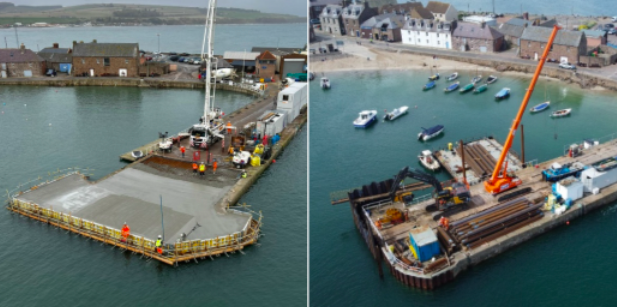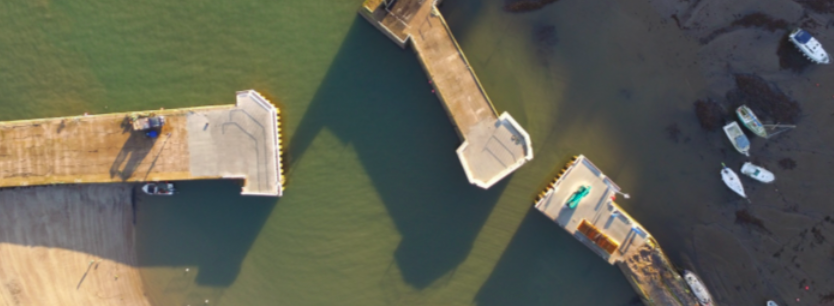Stonehaven Piers Reconstruction
Description:
Working on behalf of Aberdeenshire Council, our valued installer TMS Ltd were appointed as Principal Contractor to reconstruction three new pier heads in Stonehaven Harbour Aberdeenshire. The three new pier heads encapsulated the existing Net Pier, South Pier and Fish Jetty structures that had been considered to have reached the end of their serviceable life and at risk of failure if their condition were allowed to continue to degrade.
The full scope of the project included:
Installation of DYWIDAG Marine Ties to sheet piled wall system to support the berthing face retaining wall. 50 mm dia Gewi Bar was specified in varying lengths to provide 6 no longitudinal Tie Rods from ‘dead-mans’ anchors at the existing old quay wall, to terminate through the back Waling’s of the new quay wall.
S355 grade Gusseted angled plates were designed & manufactured by DYWIDAG and installed by TMS to provide anchorage for the inner corner bracing Ties, installed within the inner pan of the newly constructed sheet piled quay wall. A 1100 kN 50mm Jack was utilized to stress the Tie Bars before locking nuts were installed.
Procurement of approx. 200-tonnes sheet piles, 400m3 of concrete, 1000 tons
imported aggregates and 1000t arisings off-site.
Partial demolition of the existing piers, including underwater demolition of
a concrete cill structure between the South and Fish Jetties.
Installation of interlocking steel sheet piles to three sides each pier,
enclosing the existing piers.
Design and installation of sacrificial anode cathodic protection system to
the sheet piles.
Installation of DYWIDAG Tie Rods and backfill within the sheet piles to
form the new pier substructures.
Casting of perimeter of reinforced concrete capping beams to the sheet
piles, including installation of mooring rings and access ladders.
Casting of a new reinforced concrete pier deck, including ducts and
access chambers. This included spare ducts for future proofing the piers.
Fabrication and installation of a new boom gate system between the Fish
Jetty and South Pier to protect the inner harbour

The piling work was undertaken using Movax and impact hammer piling equipment on a 45t excavator supported by cranes (45t or 25t crawler cranes). The piles were installed both from barge, but then moving to the pier deck
following structural assessment. The supporting cranes were also based on the piers to assist the pitching of the 12m long sheet piles.
A modular barge and tug boat were used during the busy tourist months to transport most of the plant and equipment between the piers as two of the three were inaccessible for delivers with articulated lorries and smaller lorry movements would have increased the impact on local and tourist traffic. Due to the age and uncertainty over the existing piers structural integrity; vibration and tilt monitoring systems were set up to ensure there was no movement on the piers during the loading and piling works. These attached onto the existing piers during the works and were set with trigger warnings that would alert the construction team if movement occurred. The existing concrete decks and some masonry were demolished, and reinforced concrete capping beams and slabs constructed. By using a bolted cantilevered falsework system on the seaward side of the sheet piles, TMS were able to cast the capping beams safely over water. A boom gate system, used to create a sanctuary harbour between two piers during storms had to be replaced. An existing underwater concrete cill was removed, and a new cill, guides and boom gates were fabricated and installed.

The bottom cill was replaced with a permanent boom gate that was welded in place by divers. The boom gate guides also required underwater welding. Each pier had new handrails, mooring rings and other furniture installed. The bottom brackets of the ladders, being permanently submerged, were also welded underwater by divers .The exposed coastal location and strong winds meant that the working weather window was between May and November as the piers are frequently inundated with seawater outside these months. Therefore, close monitoring of weather forecasts and efficient use of calm periods were required to successfully complete the project without having to work into the winter months. The project, which was finished ahead of programme and under budget

Source: dywidag.com
